BUICK LESABRE 1993 Owners Manual
Manufacturer: BUICK, Model Year: 1993, Model line: LESABRE, Model: BUICK LESABRE 1993Pages: 324, PDF Size: 17.02 MB
Page 201 of 324
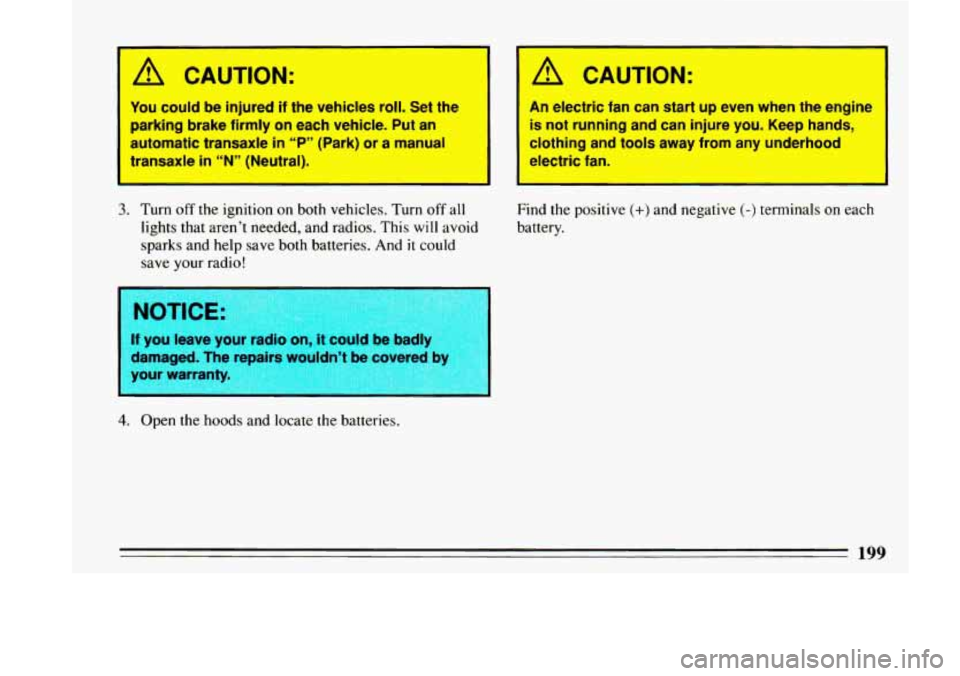
’
A CAUTION:
You could be injured if the vehicles roll. Set the
parking brake firmly on each vehicle. Put an
automatic transaxle in
“P” (Park) or a manual
transaxle
in “N” (Neutral).
3. Turn off the ignition on both vehicles. Turn off all
lights that aren’t needed, and radios. This will avoid
sparks and help save both batteries. And
it could
save
your radio!
If you leave your radio on, It could be my
damaged. The repairs wouldn’t be covered by
your warranty.
1
4. Open the hoods and locate the batteries.
‘
A CAUTION:
An electric fan can start up even when the engine
is not running and can injure you. Keep hands,
clothing
and tools away from any underhood
electric fan.
I
Find the positive (+) and negative (-) terminals on each
battery.
Page 202 of 324
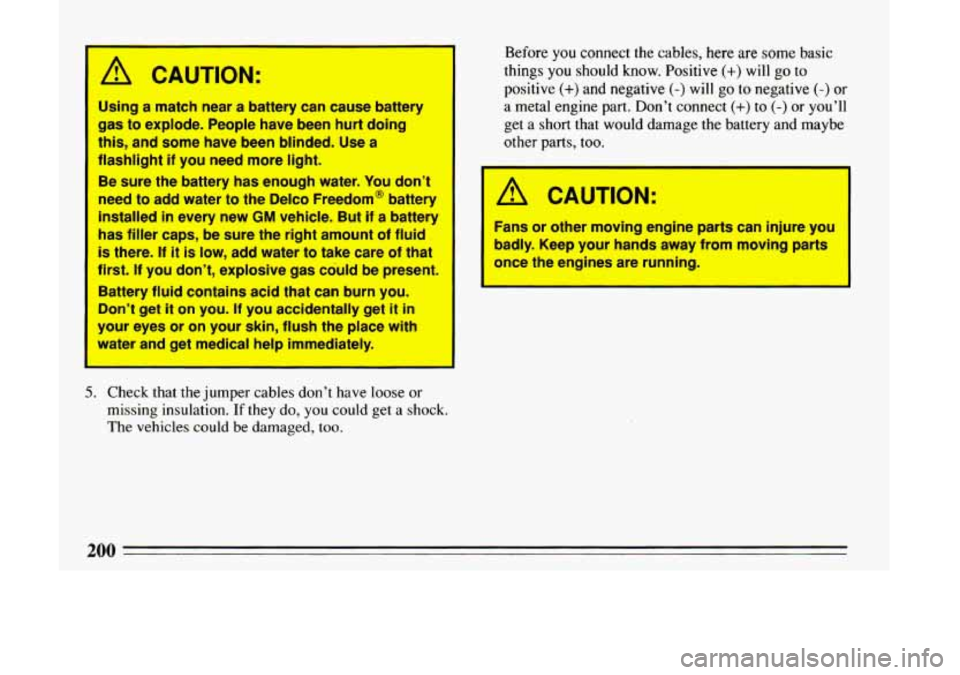
A CAUTION:
Using a match near a battery can cause battery
gas to explode. People have been hurt doing
this, and some have been blinded. Use a
flashlight
if you need more light.
Be sure the battery has enough water.
You don’t
need to add water to the Delco Freedom@ battery
installed in every new GM vehicle. But if a battery
has filler caps, be sure the right amount of fluid
is there. If it is low, add water to take care of that
first. If you don’t, explosive gas cduld be present.
Battery fluid contains acid that can burn you.
Don’t get it on you. If you accidentally get it in
your
eyes or on your skin, flush the place with
water and
get medical help immediately.
5. Check that the jumper cables don’t have loose or
missing insulation. If they do, you could get a shock.
The vehicles could
be damaged, too. Before
you connect the cables, here
are some basic
things
you should know. Positive (+) will go to
positive
(+) and negative (-) will go to negative (-) or
a metal engine part. Don’t connect
(+) to (-) or you’ll
get a short that would damage
the battery and maybe
other parts, too.
A CAUTION:
. ms or other moving engine parts can injure you
badly.
Keep your hands away from moving parts
once the engines
are running. I I I
200
Page 203 of 324
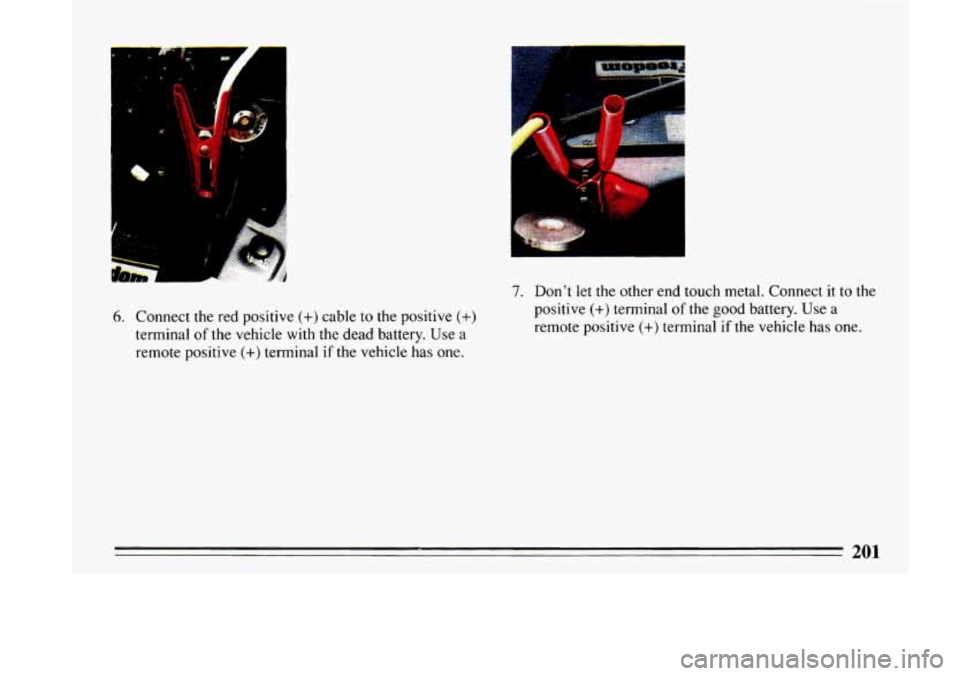
---
.-
.. 1:
t
6. Connect the red positive (+) cable to the positive (+)
terminal of the vehicle with the dead battery. Use a
remote positive
(+) terminal if the vehicle has one.
7. Don't let the other end touch metal. Connect it to the
positive
(+) terminal of the good battery. Use a
remote positive
(+) terminal if the vehicle has one.
201
Page 204 of 324
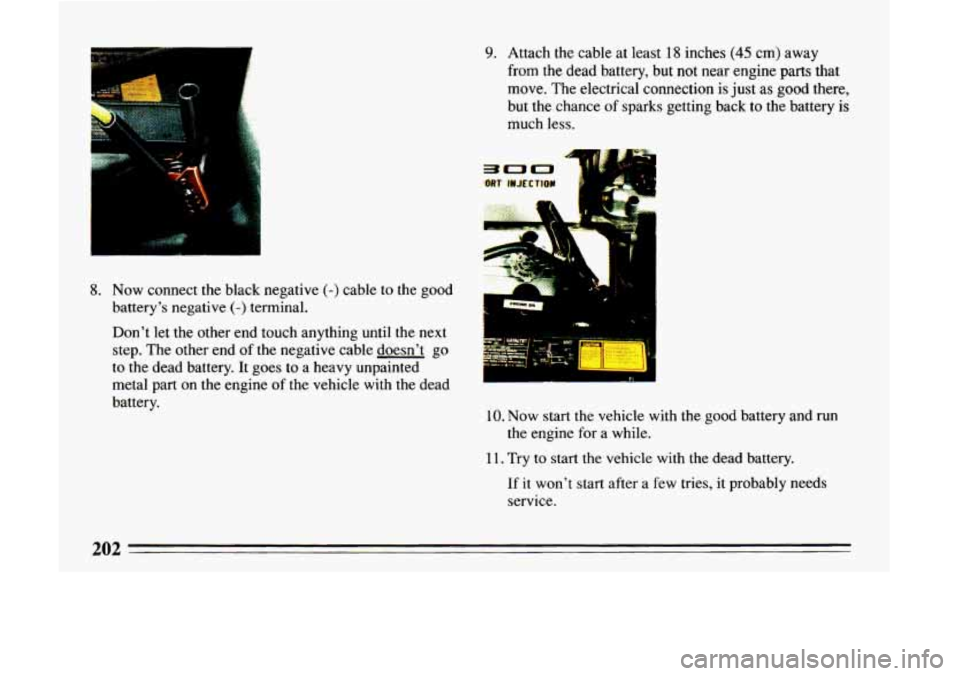
8. Now connect the black negative (-) cable to the good
battery’s negative
(-) terminal.
Don’t let the other end touch anything until the next
step. The other end
of the negative cable doesn’t go
to the dead battery. It goes to
a heavy unpainted
metal part on the engine
of the vehicle with the dead
battery.
9. Attach the cable at least 18 inches (45 cm) away
from the dead battery, but
not near engine parts that
move. The electrical connection is just
as good there,
but the chance of sparks getting back to the battery
is
much less.
R
10. Now start the vehicle with the good battery and run
11. Try
to start the vehicle with the dead battery.
the
engine for a while.
If it won’t start after a few tries, it probably needs
service.
Page 205 of 324
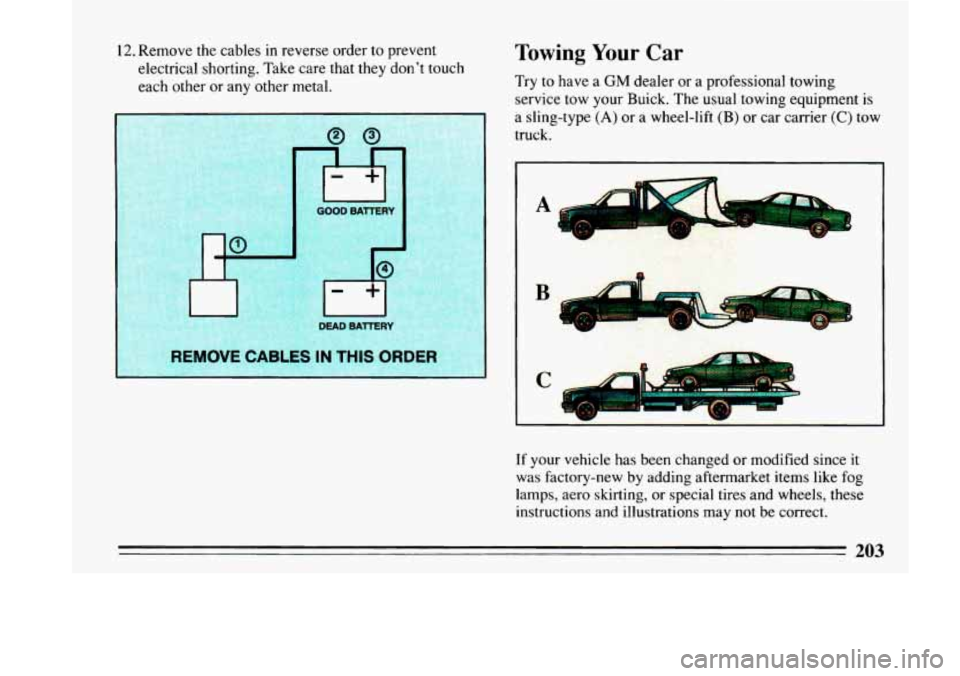
12. Remove the cables in reverse order to prevent
electrical shorting. Take care that they don't touch
each other
or any other metal.
rp+,
GOOD BATTERY
I:
Towing Your Car
Try to have a GM dealer or a professional towing
service tow your Buick. The usual towing equipment is
a sling-type
(A) or a wheel-lift (B) or car carrier (C) tow
truck.
I
If your vehicle has been changed or modified since it
was factory-new by adding aftermarket items like fog
lamps, aero skirting, or special tires and wheels, these
instructions and illustrations may not be correct.
203
Page 206 of 324
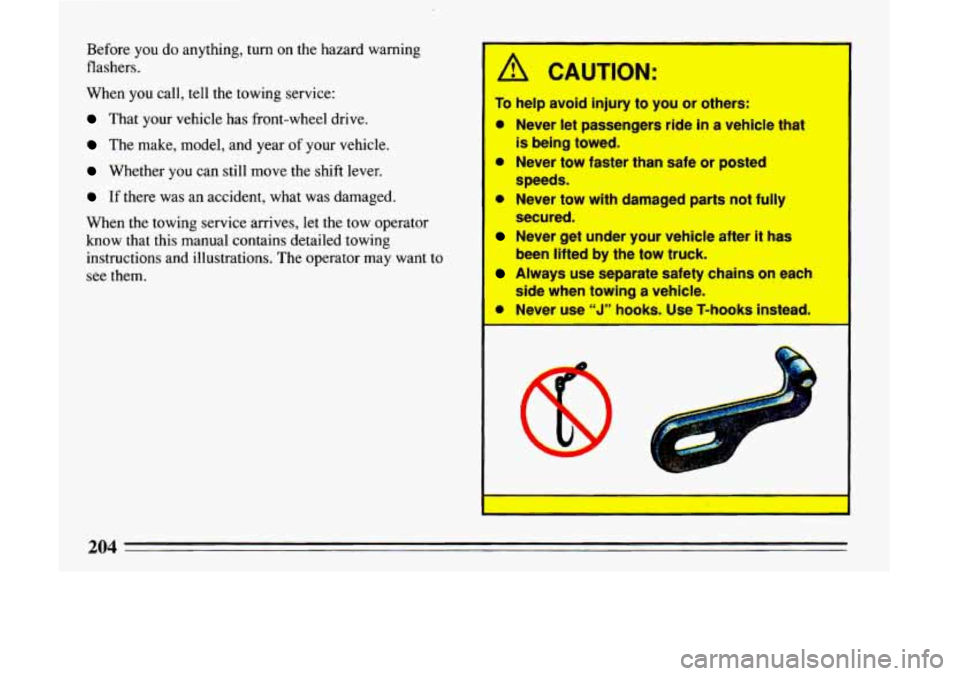
Before you do anything, turn on the hazard warning
flashers.
When you call, tell the towing service:
That your vehicle has front-wheel drive.
The make, model, and year of your vehicle.
Whether you can still move the shift lever.
If there was an accident, what was damaged.
When the towing service arrives, let
the tow operator
know that this manual contains detailed towing instructions and illustrations. The operator may want to
see them.
A CAUTION:
To help avoid injury to you or others:
0 Never let passengers ride in a vehicle that
@ Never tow faster than safe or posted
0 Never tow with damaged parts not fully
Never get under your vehicle after it has
Always use separate safety chains on each
@ Never use “J’* hooks. Use T-hooks instead.
is being towed.
speeds.
secured.
been lifted
by the tow truck.
side when towing
a vehicle.
rn
204
Page 207 of 324
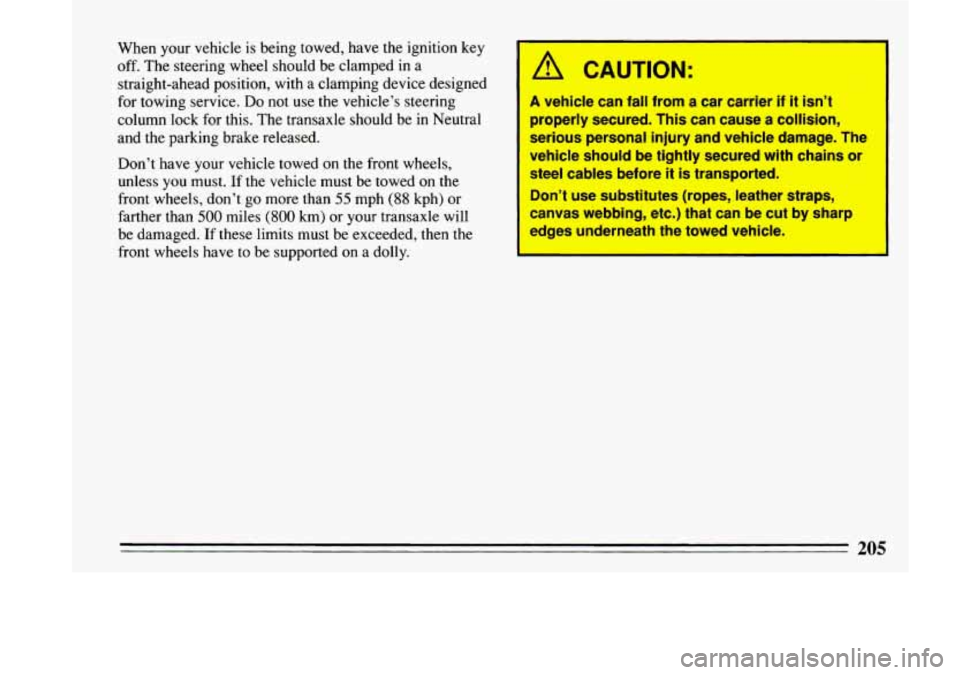
When your vehicle is being towed, have the ignition key
off. The steering wheel should be clamped in a
straight-ahead position, with a clamping device designed
for towing service.
Do not use the vehicle’s steering
column lock for this. The transaxle should be in Neutral
and the parking brake released.
Don’t have your vehicle towed on the front wheels,
unless
you must. If the vehicle must be towed on the
front wheels, don’t
go more than 55 mph (88 kph) or
farther than
500 miles (800 km) or your transaxle will
be damaged.
If these limits must be exceeded, then the
front wheels have to be supported on a dolly.
-
A CAUTION:
A vehicle can fall from a car carrier if it isn’t
properly secured, This can cause a collision,
serious personal injury and vehlcle damage. The
vehicle should be tightly secured with chains
or
steel cables before it is transported.
Don’t use substitutes (ropes, leather straps,
canvas webbing, etc.) that can be cut by sharp
zdges underneath the towed vehicle.
Page 208 of 324
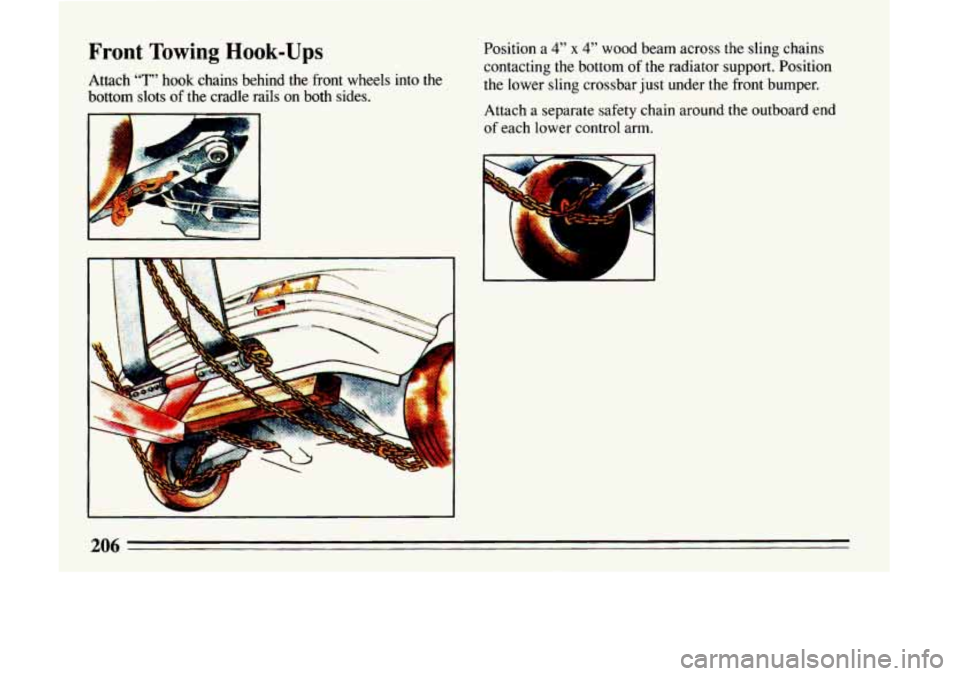
Front Towing Hook-Ups Position a 4” x 4” wood beam across the sling chains
contacting the bottom
of the radiator support. Position
the lower sling crossbar just under
the front bumper.
Attach a separate safety chain around the outboard
end
of each lower control arm.
Attach
“T” hook
chains behind the front wheels into the
bottom slots
of the cradle rails on both sides.
I
Page 209 of 324
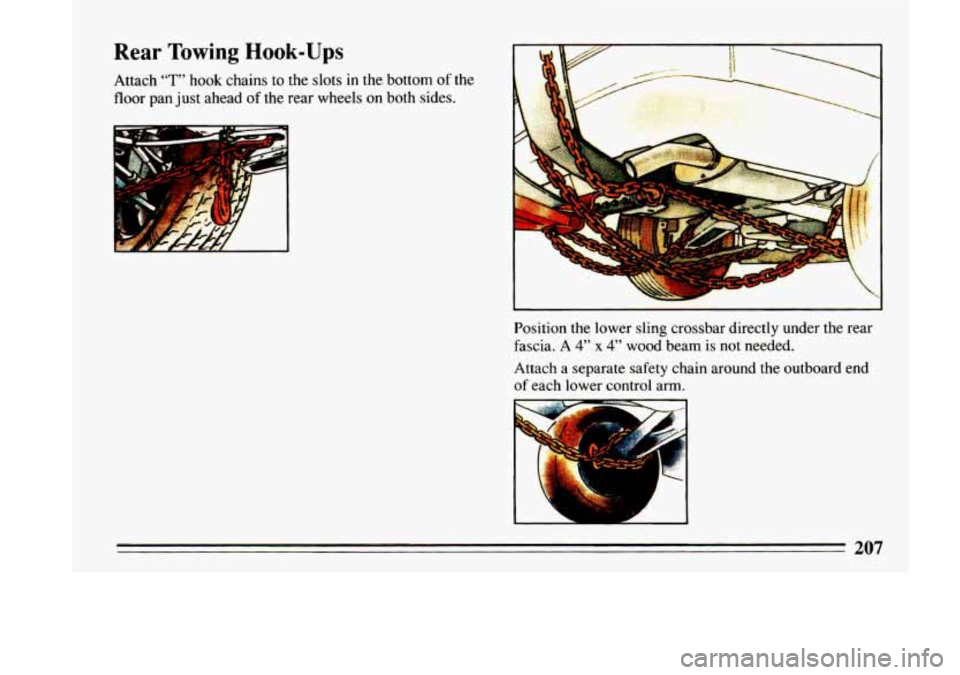
Rear Towing Hook-Ups
Attach “T” hook chains to the slots in the bottom of the
floor pan just ahead
of the rear wheels on both sides.
‘b L
. ”-
ir,
C
d-
Position the lower sling crossbar directly under the rear
fascia. A
4” x 4” wood beam is not needed.
Attach a separate safety chain around the outboard end
of each lower control arm.
3n7
Page 210 of 324

Engine Overheating
You will find the warning light about a hot engine on
your Buick instrument panel,
If you have the optional gage cluster, you may also have
a coolant temperature warning gage.
If Steam Is Coming From Your Engine:
CAUTION:
eam from an overheated engine can burn you
badly, even if you just open
the hood. Stay away
from
the engine if you see or hear steam coming
from
it. Just turn it off and get everyone away
From the vehicle until
it cools down. Wait until
there
is no sign of steam or coolant before
opening the hood.
If you keep driving when your engine is
overheated, the liquids in it can catch fire. You or
others could be badly burned. Stop your engine
if it overheats, and get out of the vehicle until the
engine is cool. badly
damaged. The costly
covered by your warranty.
If No Steam Is Coming From Your Engine:
If you get the overheat warning but see or hear no
steam, the problem may not be too serious. Sometimes
the engine can get a little too
hot when you:
Climb a long hill on a hot day.
Stop after high speed driving.
Idle for long periods in traffic.
Tow a trailer.
If you get the overheat warning with no sign of steam,
try this for a minute or so:
1. Turn off your air conditioner.
2. Turn on your heater to full hot at the highest fan
speed and open the window as necessary.
3. If you’re in a traffic jam, shift to “N” (Neutral).
208